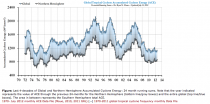By Tom a. Nelson, Nelson Blogspot
Fraudster Michael Mann: “it’s part of a trend, Katrina, the record season of 2005 was part of a trend towards more destructive storms”
On the Green Front - Dr. Joseph Romm and Dr. Michael Mann - 08/15/12 at On the Green Front
Mann at the 40:40 mark: “One of the more robust predictions is that in the Atlantic, hurricane intensities have increased and they will likely continue to increase, and so, it’s part of a trend, Katrina, the record season of 2005 was part of a trend towards more destructive storms..”
Accumulated Cyclone Energy Index (Maue) shows the activity is actually at the lowest level in over 32 years. Don’t expect these climate politically driven, ‘self proclaimed experts’ to ever get it right.
See also this detailed PJM post on Michael Mann - The ghost of climate past here.
--------------------
German National Weather Service: “No Significant Trend To More Drought In Europe...Dryness La Nina -Related”
By P Gosselin on 17. August 2012
In layman’s terms, that means: Forget the man-made global warming poppycock!
There’s been a lot of bed-wetting going on about “increasing” extreme weather events like droughts, floods, heat, tornadoes and dry periods.
All because of climate change? Not so, says the German Weather Service DWD (surprisingly)!
Precipitation over much of Europe over 2011 was 80% or less than normal levels.
The DWD posted 2 days ago an unusually level-headed, sober expert report on what’s behind the dry period that Europe has been experiencing over the last 2 year and half.
Their findings are a real cold water deluge on all the alarmist claims we’ve been hearing in the media over the last weeks.
The DWD’s conclusion: “There’s no long-term significant trend. The suspect is a two-year La Nima impact in connection with a positive North Atlantic Oscillation”. Hat-tip: Meteorologist K.E. Puls.
What follows is a translation of their German summary (my emphasis):
Summary
The dry period of winter 2011/12 and spring 2012 was as a whole not so strongly pronounced like in the spring and autumn of a year earlier (for the previous year, see Trachte et al. 2012), but it can be ranked as local and extreme. Wide areas of Europe were impacted, and to different extents and at different time periods. Over the Iberian Peninsula, this period of drought began in December 2011 and then spread to Western, Central and Southern Europe by March. Heavy precipitation in Western Europe then ended the period of low precipitation. However, ground moisture in April and May remained generally very low, thus causing the hydrological drought to extend over the entire spring of 2012. Over the long-term, since the beginning of the 20th century, there is no significant general trend to more dryness in Europe. However, there are indications that in certain smaller regions dryness and periods of strong precipitation have tended to become more extreme over the last 35 years, foremost the Iberian Peninsula during the winter.
The main meteorological cause of the drought, as is the case for last spring and in fall 2011, is the widespread and stronger high pressure influence in these regions. After examining the corresponding data and some new investigations of the literature, there’s a strong suspicion that a two-year long La Nina (i.e. two La Nina-events in row) were the main cause in all these cases - in connection with a positive North Atlantic Oscillation.”
The text speaks for itself. We are dealing with natural causes. Moreover the authors add:
Record drought for 2012 hardly took place. For example in Uccle (Belgium), where the data-sets begin in the 19th century, even during the dry March-2012 the monthly precipitation amount and the number of days of precipitation was considerably higher than the record low of 1993. In Germany, the spring of 2012 was the 6th driest since the beginning of the 20th century.”
The DWD presents other long-term (non)trends:
Data-sets from region’s middle for individual seasons (See Fig. 9 for winter and spring) do not show any clear trend for any region. Instead we see more ‘or less pronounced year-to-year variability.”
Good to see there are a few meteorologists left at the German National Weather Service who are still sober and have not yet become all drugged up with the global warming cult religion. I wonder if they’ll be allowed to issue reports in the future.





